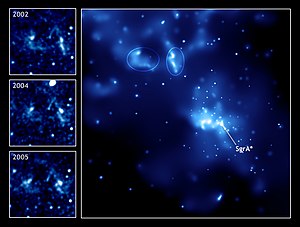Sagittarius A*: Difference between revisions
m Move ref to end of sentence |
m Simplify link to light echo |
||
| Line 1: | Line 1: | ||
{{sections}} |
{{sections}} |
||
[[Image:gcle.jpg|thumb|300 px|Sgr A* (centre) and two [[light echo |
[[Image:gcle.jpg|thumb|300 px|Sgr A* (centre) and two [[light echo]]es from a recent explosion (circled)]] |
||
{{Starbox short |
{{Starbox short |
||
| name=Sagittarius A* |
| name=Sagittarius A* |
||
Revision as of 12:29, 28 June 2008
This article needs to be divided into sections. |

| Observation data Epoch J2000 Equinox J2000 | |
|---|---|
| Constellation | Sagittarius |
| Right ascension | 17h 45m 40.045s[1] |
| Declination | −29° 0′ 27.9″[1] |
| Distance | 25,900 ± 1,400 ly (7,940 ± 420[2] pc) |
| Spectral type | Radio source |
Sagittarius A* (pronounced "A-star", standard abbreviation Sgr A*) is a bright and very compact source of radio emission at the center of the Milky Way Galaxy, part of a larger astronomical feature at that location (Sagittarius A). On October 16, 2002, an international team led by Rainer Schödel of the Max Planck Institute for Extraterrestrial Physics reported the observation of the motion of the star S2 near to Sagittarius A* for a period of ten years, and obtained evidence that Sagittarius A* is a highly massive compact object[3]. From examining the Keplerian orbit of S2, they determined the mass of Sagittarius A* to be 2.6 ± 0.2 million solar masses, confined in a volume with a radius no more than 17 light-hours (120 AU). Later observations determined the mass of the object to be about 3.7 million solar masses within a volume with radius no larger than 6.25 light-hours (45 AU) or about 4.2 billion miles.[4][5] For comparison, Pluto orbits our Sun at a distance of 5.51 light-hours or 3.7 billion miles.
This is compatible with, and strong evidence in support of, the hypothesis that Sagittarius A* is associated with a supermassive black hole. While it is possible for the observed mass within the observed volume limit to be distributed among multiple objects, any such objects would undergo orbital collapse into a single black hole anyway within a few hundred years at most, a negligible amount of time compared with the lifetime of the galaxy.[2]
Several teams of researchers, including groups at the National Radio Astronomy Observatory and at the Shanghai Astronomical Observatory, have attempted to image Sagittarius A* in the radio spectrum using Very Long Baseline Interferometry. The images obtained have been consistent with the Sagittarius A* radio emissions being associated with the accretion disc and relativistic jets of a supermassive black hole.
Sagittarius A* is "associated" with the supermassive black hole; what is seen is not strictly the black hole itself. The observed radio and infrared energy emanates from gas and dust heated to millions of degrees while falling into the black hole; the black hole itself emits only Hawking radiation at a negligible temperature, on the order of 10−14 kelvins. In the near future, astronomical interferometers may allow the direct imaging of the event horizon.
In November 2004 a team of astronomers reported the discovery of the first well-confirmed intermediate-mass black hole in our Galaxy, orbiting three light-years from Sagittarius A*. This black hole of 1,300 solar masses is within a cluster of seven stars, possibly the remnant of a massive star cluster that has been stripped down by the Galactic Centre.[6][7] This observation may add support to the idea that supermassive black holes grow by absorbing nearby smaller black holes and stars.
Coordinates (J2000): RA 17h 45m 40.045s Dec. −29.00775 degrees (About 10 degrees to the west of the center of the constellation Sagittarius, towards Scorpius)
Further reading
- Melia, Fulvio, The Black Hole in the Center of Our Galaxy, Princeton U Press, 2003
- Melia, Fulvio, The Galactic Supermassive Black Hole, Princeton U Press, 2007
- Eckart, A., Schödel, R., Straubmeier, C., The Black Hole at the Center of the Milky Way, Imperial College Press, London, 2005
References
- ^ a b Data and scientific papers about Sagittarius A*
- ^ a b Eisenhauer, F., Schödel, R. et al. "A geometric determination of the distance to the galactic center." The Astrophysical Journal, 597, L121–L124, (2003).
- ^ Schödel, R. et al. "A star in a 15.2-year orbit around the supermassive black hole at the centre of the Milky Way." Nature, 419, 694–696, (2002).446
- ^ Ghez, A.M. et al. "The First Measurement of Spectral Lines in a Short-Period Star Bound to the Galaxy's Central Black Hole: A Paradox of Youth." The Astrophysical Journal, 586, L127–L131, (2003)
- ^ UCLA Galactic Center Group
- ^ "Second black hole found at the centre of our Galaxy". News@Nature.com. Retrieved 2006-03-25.
- ^ "The nature of the Galactic Center source IRS 13 revealed by high spatial resolution in the infrared". Retrieved 2007-01-07.
External links
- UCLA Faculty Research presentation on Sagittarius A* (Video)
- 2004 paper deducing mass of central black hole from orbits of 7 stars (arxiv preprint)
- ESO video clip of orbiting star (533 KB MPEG Video)
- Star Orbiting Massive Milky Way Centre Approaches to within 17 Light-Hours ESO Press Release, October 16 2002
- Max Planck page on the galactic center, with animation
- The Proper Motion of Sgr A* and the Mass of Sgr A* (PDF)
- NRAO article regarding VLBI radio imaging of Sgr A*
